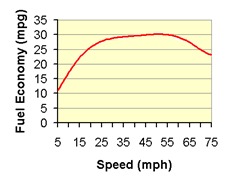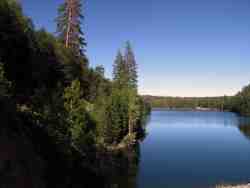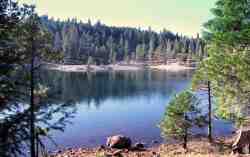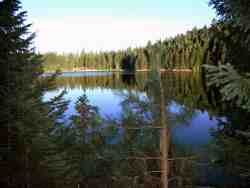Fuel Economy:
Why Burn More Gas Than You Need To?
In today's reality, fuel economy is on everyone’s mind. We are all driving these big block V8's and wondering how much longer we can afford the fuel bill. While we cannot predict fuel costs in the future, we can control our present fuel economy... at least to a point.

However, some of these big V8's are, for obscure reasons, able to get into the eleven plus miles per gallon range. I did achieve this level of fuel economy once on a trip to Los Angeles. Using GPS numbers, I actually pulled 11.3 mpg. Needless to say, I was pleasantly surprised! However, I've not been able to duplicate this since.
I'm just going to throw out some ideas in random order. Some of the ideas may be great for you and your individual situation, but these same ideas may be a "done that... been there" scenario for someone else. Take what you want or need and ignore the rest.
WEIGHT:
So, let's talk about weight. Bottom line... pounds cost dollars. It is an engineering fact that the more something weighs, the more it is going to cost to lug it around. Therefore, if you do not need it, get rid of it.
Remember the mileage I mentioned above? I can tell you that I was running lean and mean. I had just inventoried my rig and had it weighed. It was well below the maximum GVWR (Gross Vehicle Weight Rating).
I was not running it empty though. I had a full fridge and all the stuff we normally used to go camping. But I only carried the things that I needed for the trip that I was on. That's the goal... keeping the stuff out of the rig that really isn't necessary.
As I remember, I could have put another 1,000 lbs of CCC (Cargo Carrying Capacity) in the thing, and it still would have been below GVWR specs.
We all have our toys that we want to bring with us. However, we simply must understand our limits when it comes to packing accessories. Over time, we will have a tendency to clutter up our rigs, and it will take a concentrated effort to get rid of extra stuff that fills up any void.
clutter out of there lives.
And Be Fuel Efficient
TIRE PRESSURE:
Along with keeping weight under control comes tire pressure. You are not going to get good fuel economy if your tires are under inflated. That is just the way it is.
I'm not going to go into lot of why's and wherefore's... just look on the tire, and it will tell you what the air pressure is supposed to be. You can also look at your VIN (Vehicle Identification Number) to see what the proper air pressure front and back should be.
Along with proper inflation, your best fuel economy will occur while keeping your speed down to 55 mph or less. High speed and wind resistance will really hurt your mileage.
Money On Gas
TUNE-UPS:
Factory recommended tune-ups are also a must. Although our Class C Motorhomes are rugged vehicles, they do require maintenance. Stuff like a fuel filter, air filter, regular oil changes, etc. will go a long way to make sure that you are getting maximum fuel economy.
able to spot potential problems.
On the other hand, stuff can always happen. Things break... that's just the way it is. You can, however, go a long way in preventing unexpected problems if you deal with maintenance in a proactive way.
You Are Not Driving Around
STAY PUT:
Stay longer in one place. Our dirty little secret is that we did not buy our Class C Motorhomes to drive. We bought the things to go park somewhere nice. I think that sometimes we forget that. But, the logic is there... your best fuel economy occurs when the rig is parked.
When camping, the only potential requirement for burning fuel is the gen-set. There again, logic dictates that an 18.5 cubic inch 4 cylinder engine is going to have better fuel economy than a 460 cubic inch V8! Granted, I'm stretching things a bit... but the point is, staying in one place longer will knock your fuel bill down.
We pull a 2006 Honda Civic as our TOAD... (I think a TOAD is a type of frog. FROG = Four Rolling On Ground... :>) Actually, a TOAD vehicle is a towed vehicle, whether it is 4 wheels down or 2 wheels on a dolly.
Anyway, we get around 35-40 mpg with this Honda. So, our game plan is to drive between 2 to 3 hundred miles and then use the car to explore. We stay in our campsite until we feel that we have "milked the area" of all the cultural, historic, and recreational information that our location has to offer. We can easily end up not having to move for weeks at a time... it just depends.
I'm going to go off subject (again) a little bit, but when we are talking fuel economy, we are, in reality, discussing energy conservation. A huge gain in this energy conservation comes from changing out our incandescent bulbs to a more efficient LED or fluorescent bulb. This will save you huge amounts of amp/hours, and allow you to stay off the grid for a longer time. There again, you will stay parked and not be driving. Conserving your big deep cycle battery will make your off road (boondocking) experience much more enjoyable.
Simply put, it costs money to lug stuff around. An extra 100 pounds in your vehicle could reduce your MPG by up to 2 percent.
This is a variable number that depends on vehicular size and horsepower. Larger vehicles have a greater tolerance for additional weight. This explain why it is that a 25' Class C Motorhome gets about the same mileage as 31' Class C Motorhome when driven at the same speeds and load capacity.

As I stated above, all things being equal, if you run a light rig and drive between 55 and 60 mph, you will get your best fuel economy.
This is not rocket science. Essentially, you can pretty much assume that for every 5 mph you are driving over 60 mph has the same result as spending and additional $0.25 per gallon on fuel.
PROPANE FUEL:
An area that is easily overlooked when trying to save dollars on fuel is our propane gas consumption. Just by leaving the water heater off will save significantly in the propane fuel bill. Realistically, however, we cannot leave the heater off all the time because we do need hot water.
So, I have found that a good way around these two extremes (to have it on all the time or off all the time) is to consolidate hot water usage down to a specific time of day.
stay warm for a long time.
You only want it just hot enough to do the job. It's not that hard really, just plan ahead.
Take your shower, shave, or perform whatever hygiene requirements you have. As an example, if you do this just after using hot water to wash the evening dishes, you will more than likely use most, if not all, of the 6 gallons of water that is normally heated in the hot water heater.
If you only want to wash dishes, you can boil 1/2 gallon of water on the stove with less propane gas than heating 6 gallons in the water tank.
AFTERMARKET HEATERS:
Not using your factory convection heater will give you good propane fuel economy. There are many types of aftermarket heaters available that will give you good fuel savings and potentially increased performance.
Things were way different back then. When you bought gas, they may have given you a camera... now if you buy a camera, they may give you a gas card!
Seriously, we must all do what we can to obtain the best fuel economy possible. We have lots of time and dollars invested in our Class C Motorhome lifestyles. It only makes sense to do what we can to make our dollars stretch as far as possible.

Retrun To The Top Of The Page
Leave Fuel Economy: Why Burn More Gas Than You Need To? Page And Return To RV Tips: Some Thoughts On Bringing Out The Best In
Your Class C Motorhome
Leave Fuel Economy: Why Burn More Gas Than You Need To? And Go To The Class C Motorhome: How To Achieve The Maximum RV Lifestyle! Page
YOUR STORIES
Onan AC Generator Wouldn't Start
1995 Tioga Montara
Had a Leak - Ouch!
A Simple Way To Put An Electrical Thermostat On A Small Space Heater
In A Truck Camper!
A Great Destinaton, With An Unexpected Outcome!
INTERNET SALE!!
Now Available From Magellan! - RoadMate RV9145-Lm 7" Touchscreen GPS W/Lifetime Maps Portable Receiver Made For Motorhomes...
With an Internet Price Of Just $249.08 At Camping World!
Including Lifetime Maps!
Test Link
Below: For An Alternative Destination... A Four Mile Hike Around Sugar Pine Reservoir

A Good Place To Begin The Joshua M. Hardt Memorial Trail Is At The Dam. This 3.5 Mile Trail Is Good For Foot Traffic And Bicycles... No Motorized stuff

The Manzanita Day Use Area Is A Good Place To Sit And Watch The Wind
Play With The Water!

Another View From The Joshua M. Hardt Memorial Trail... Morning and Evening Are The Best Times To Hike This Trail. The Still Reflections Will Capture Your Attention

You May Want To Bring A Camera... There Are Large Birds Of Prey High In The Ski






